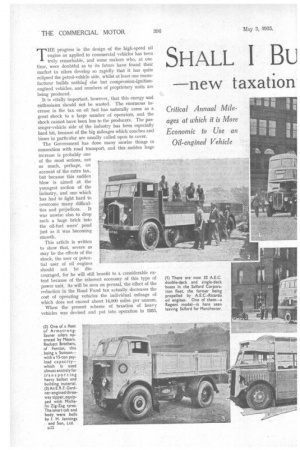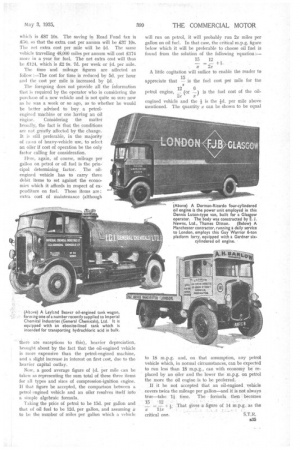SHALL I Bu
Page 46

Page 47

Page 48

Page 49

If you've noticed an error in this article please click here to report it so we can fix it.
AN OILER?
—new taxation )roblems solved
THE progress in the design of the high-speed oil engine as applied to commercial vehicles has been truly remarkable, and some makers who, at One time, were doubtful as to its future have found their market in oilers develop so rapidly that it has quite eclipsed the petrol-vehicle side, whilst at least one manu
facturer builds nothing else but compression-ignitionengined vehicles, and numbers of proprietary units are being produced. It is vitally important, however, that this energy and
enthusiasm should not be wasted. The enormous increase in the tax on oil fuel has naturally come as a great shock to a large number of operators, and the shock cannot have been less to the producers. The passenger-vehicle side of the industry has been especially hard bit, because of the big mileages which coaches and
buses in particular are usually called upon to cover. The Government has done many unwise things in connection with road transport, and this sudden huge increase is probably one of the most serious, not so much, perhaps, on
account of the extra tax, but because this sudden blow is aimed at the youngest section of the
industry, and one which has had to fight hard to overcome many difficul ties and prejudices. It was unwise also to drop such a huge brick into the oil-fuel users' pond just as it was becoming smooth.
This article is written to show that, severe as may be the effects of the shock, the user or potential user of oil engines should not be dis couraged, for he will still benefit to a considerable ex tent because of the inherent economy of this type of power unit. As will be seen on perusal, the effect of the reduction in the Road Fund tax actually decreases the cost of operating vehicles the individual mileage of which does not exceed about 14,000 miles per annum. When the present scheme of taxation of heavy vehicles was devised and put into operation in 1933, imposing Id. per gallon tax on oil, as compared with 8d. per gallon on petrol, and inflicting especially severe Road Fund duties on oil-engined vehicles, in order to compensate for the difference in the fuel tax, most users concluded that they knew the worst.
They thought that they would be safe in deciding upon the type of vehicle to use, with the certainty that nothing drastic was likely to occur, for some time, which would affect any decision then made. Now they find that they were wrong. The Government has turned the whole scheme upside down, reduced the Road Fund taxes on oil-engined vehicles to the same level as those on petrol-engined chassis and increased the taxation of oil fuel by no less than 700 per cent.
The problem thus created has to be considered from several angles if all the possible cases are to be discussed. Some operators are chiefly interested in the effect that this alteration is going to have on the cost per annum. Others are more concerned with the cost " per mile that must be allowed under the new conditions, and yet a third class, comprising jobbing hauliers and contract-carriage operators, who have to quote for all kinds of work, must have as a basis for calculations figures for time and mileage charges.
. All hauliers who operate oil-engined vehicles have regular customers for whom they are doing work at prices fixed some time ago. If possible, they prefer not to have to . ask the customer to allow the current rate to be varied, but they are anxious to know how far they can persist in that attitude. They wish to know whether there is a sufficient margin of profit to allow them, for some time, at any rate, to carry on at the old rate, notwithstanding the increased tax on fuel.
A good deal turns on tht figure for mileage per gallon of fuel. That is a factor which is apt to differ considerably, not only front vehicle to vehicle, but from
dayto day with the same machine. Fuel consumption .is inclined to rise quickly in the case of an oil engine Which is not reasonably well maintained. I find that there is a much wider divergence in fuel cost for the same capacity of oil-engined vehicle than in the case of petrol-engined machines. This increase in the tax makes this particular matter one of much greater consequence.
It is possible to indicate a method whereby every operator can quite easily Calculate for himself the effect of the new scheme of taxation, which will not, of course, come into• force until August 1. He can make that calculation simply by referenCe to two factors: the mileage per gallon which his vehicle is covering and the annual tax.
The cost of fuel is increased by a certain definite figure per mile. That figure can be ascertained quite easily by dividing the mileage per gallon into the extra cost of fuel. For a given annual mileage the additional cost can thus be ascertained and from the result the reduction in Road Fund tax must be deducted. One or two examples will, no doubt, make this matter plain.
Suppose I take, first of all, a vehicle of comparatively , large capacity which is consuming oil fuel at the rate of 8 m.p.g._ At the moment, the operator is probably obtaining his fuel for 5d. per gallon, including tax, and
his fuel cost is thus 0.63d. per mile (id.). After August 1,' this fuel will cost Is. per gallon and the cost per mile for fuel will thus become lid., an increase of id. per mile. Assuming that the unladen vehicle weighs just over 7 tons, the tax, if paid quarterly, would amount to £192 10s. per annum. After August 1 that sum will be reduced to £143 per annum. That saving of about £50 per annum has to be set against the extra expenditure of id. per mile on fuel. It will at once be appreciated that if only this factor be considered, the man with the small annual mileage is going to benefit. There is, indeed, a figure for annual mileage at which the saving in Road Fund tax exactly offsets the extra cost of fuel. Divide £50 by id. and the result, 13,800, is this critical mileage.
A vehicle of this class covering a lower annual mileage will cost less next year than it costs this year, whereas one with a bigger mileage will cost more under the new scheme of taxation.
Assume that a vehicle with tax and consumption as above quoted is covering 24,000 miles per annum. The extra expenditure on fuel will be 24,000 times id., which is £87 10s. The saving in Road Fund tax is £50, so that the extra cost per annum will be £37 10s. The net extra cost per mile will be Rd. The same vehicle travelling 48,000 miles per annum will cost £174 more in a year for fuel. The net extra cost will thus be £124, which is £2 9s. 7d. per week or d, per mile.
The time and mileage figures are affected as follow :=The cost for time is reduced by 5d. per hour and the cost per mile is increased by id.
Here, again, of course, mileage per gallon on petrol or oil fuel is the principal determining factor. The oilenginecl vehicle has to carry three debit items to set against the economies which it affords in respect of expenditure on fuel.: Those items are : extra cost of maintenance (although
there are exceptions to this), heavier depreciation, brought about by the fact that the oil-engined vehicle is more expensive than the petrol-engined machine, and a slight increase in interest on first cost, due to the heavier capital outlay.
Now, a good average figure of ld. per mile can be taken as representing the sum total of these three items for all types and sizes of compression-ignition engine, If that figure be accepted, the comparison .between petrol mgined vehicle and an oiler resolves itself info a simple algebraic formula.
Taking the pride of petrol to be rid. per gallon and , that of oil fuel to he 12d. per gallon, and assuming x to be the number of miles per gallon which a vehicle will run on petrol, it will probably run 2x miles per gallon on oil fuel. In that case, the critical m.p.g. figure below Which it will be preferable to choose oil fuel is found from the solution of the following equation:
15 12 =
x 2x
A little cogitation will suffice to enable the reader to
appreciate that —x is the fuel cost per mile for the petrol engine, (or _6 is the fuel cost of the oil 2X x'
engined vehicle and the is the id. per mile above mentioned. The quantity x can be shown to be equal to 18 m.p.g. and, on that assumption, any petrol vehicle which, in normal circumstances, can be expected to run less than 18 m.p.g., can with economy be replaced by an oiler and the lower the. m.p.g on petrol the more the oil engine is to be preferred.
If it be not accepted that an oil-engined vehicle covers twice the mileage per gallon—and it is not always true—take 14 time The formula then becomes
1.That gives -a -figure of 14 m.p.g. as the
critical one. S.T.R.




























































































